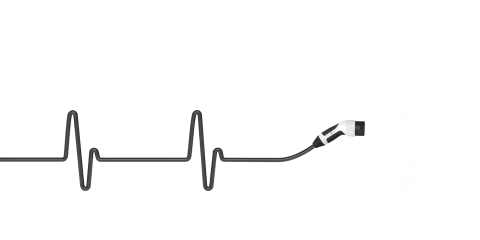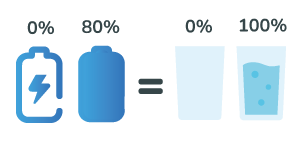09/12/2022 News
Understanding the charging curve

“I experienced a charging incident with a battery at 50%, I recovered... 6.5 kWh in 2 hours 53 minutes on a 7.7 kW Flex charger. It’s obvious that the charger was faulty [...], help!”
As an electric vehicle driver, you obviously have questions about your charging sessions on a daily basis, concerning timing, energy delivered and cost of the session. Although you expect to recover a precise amount of energy depending on the power of the charger when you recharge your vehicle, this is not necessarily the case. And so to understand more clearly, we need to figure out the charging curve!
What factors affect a charging session?
Let’s begin by stating that you can charge using an AC charger (from 3.7 kVA to 43 kVA) or a DC charger (upwards of 50 kW). These different charger models meet different needs, including domestic or slow, normal, accelerated, fast and high-power charging.
For more details on the types of chargers, please see the article: AC, DC, sockets and connectors... Which charger to charge your electric vehicle?
The following factors impact the duration and price of a charging session:
- The power accepted by the electric vehicle: it is the vehicle that dictates to the charger the power that it can accommodate in its battery, and not the reverse! Expressed in kVA or kW, the maximum power accepted by a vehicle can vary depending on the model of the electric vehicle. In practical terms, this means that a vehicle whose battery accepts maximum power of 50 kW, and which charges on a charger than can deliver 150 kW, can accept power of only 50 kW.
- The power delivered by the charger: as we have seen, the power delivered by a charger can vary from 3.7 kVA to more than 300 kW. This power delivered differs according to the place of charging: at home (between 3.7 kVA and 22 kVA) vs. a charging hub (between 50 kW and 350 kW). Lastly, the power delivered by the charger directly impacts the charging speed. The higher the delivered power, the faster the charging time (provided that the vehicle accepts the maximum power delivered by the charger).
- Battery level: Lastly, a crucial factor to remember is the state of charge of the battery before starting a charging session. The duration of a charging session will not be the same for an electric vehicle with a state of charge at 15% or at 65% when the charging session begins.
This information leads us to the following question: do you need to charge your vehicle to 100%? The answer is no, because the higher the charge flow rate at the start of the session, the faster it will drop during the charging session. Similarly, the slower the flow rate, the more constant the curve throughout the session, and the more it will drop when the charging level has reached its maximum limit, which also depends on the vehicle model, but is generally around 80%. It is highly recommended that you charge your electric vehicle between 20% and 80%, because when the battery level reaches 80%, charging speed drops considerably and the time needed to go from 80% to 100% will be similar to the time needed to go from 20% to 80%. This is known as boost charging.
To simplify, let’s compare it to filling a glass with water. To begin with we open the valve at high pressure, then we close it again gradually to low pressure, to prevent overflow. The principle is therefore the same when charging a vehicle; the maximum power is accepted by this vehicle, then the power is reduced sharply when it reaches the 80% limit and continues to drop in increments.

This comparison helps us analyse and understand a charging curve.
What is a charging curve?
The charging curve, or power curve, shown in graphic form, represents the change in the charging power according to the battery charge level over a specific period. It lets us visualize the consumption of an electric vehicle and is different from one model to another. We can illustrate this clearly in the next section.
What is its purpose?
The report provided by the graph gives a picture of the variation in consumption at the time of charging, which allows users to adapt their charging method, and ultimately optimize their energy consumption in the long term.
A charging curve is not fixed and proportional over the course of a session; it varies and reaches various peaks. There are several charging curves that differ according to the vehicle model and features. Let’s take a closer look.
How do you read a charging curve?

On the X-axis, we can see the battery state of charge expressed as a percentage, from 0% to 100%.
On the Y-axis, we can see the power delivered by the charger throughout the charging session.
The graph shows the charging curves for three different vehicles: the Chevrolet Bolt, the Hyundai Ioniq and Kona. These electric vehicles each accept maximum charging power as follows:
- Chevrolet Bolt: 50 kW,
- Hyundai Ioniq: 70 kW,
- Hyundai Kona: 75 kW.
We see that electric vehicles accept their maximum power at the start of a charging session, then there is a gradual drop when the battery reaches 60%, until the vehicle is fully charged.
We can see that during a charging session, and for all vehicle types, the power delivered is relatively low when the charging level has reached the 80% mark. Charging is faster at the beginning and takes on average between 20 and 40 minutes for normal charging, and 30 minutes for rapid charging.
Why do we need to analyse it?
Quite simply, to regulate and optimize your own electricity consumption. Understanding your own charging curve improves your ability to make decisions before charging your vehicle.
Analysing your charging curve also lets you adapt your charging method and respect the 80% limit, which enables you to optimize your vehicle battery’s service life.
In short, we can deduce that optimizing your charging time also helps you make considerable savings.
Points to remember
Before charging your vehicle it is important to understand the different factors that influence the duration and cost of a charging session, so that you can plan ahead and choose a charger that is suited to your electric vehicle. The result is controlled charging duration, a cost appropriate to the quantity of energy delivered and the best charge rate for your battery!
*according to the maximum power accepted by the EV

